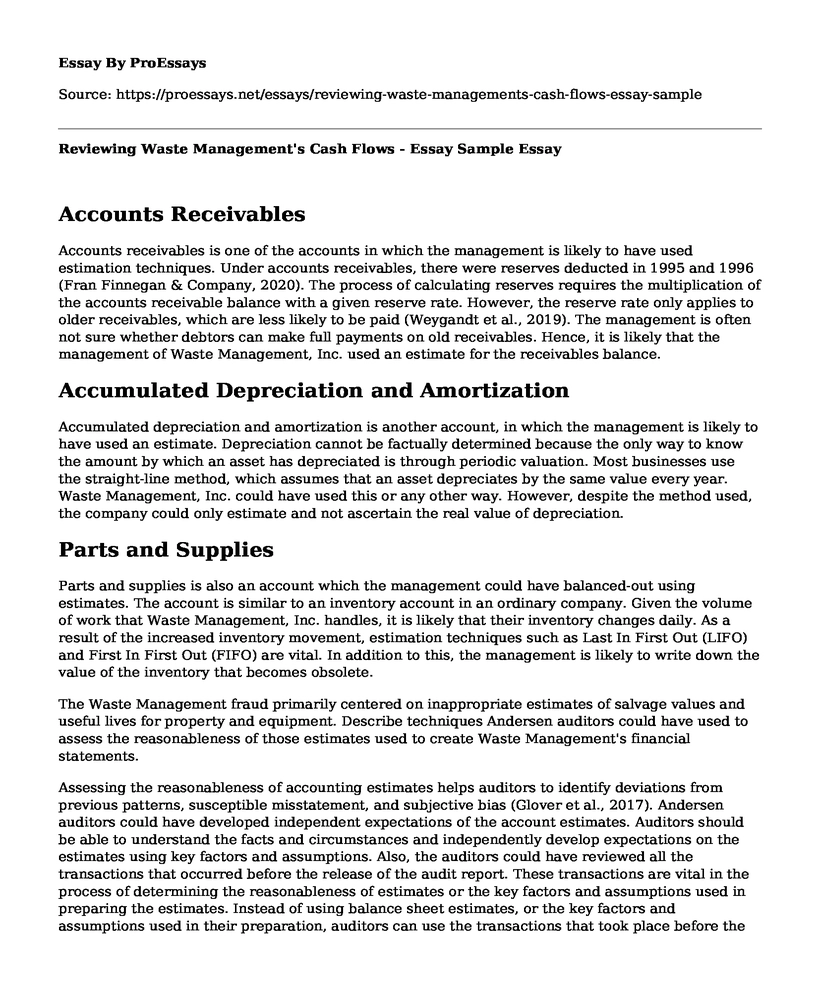Accounts Receivables
Accounts receivables is one of the accounts in which the management is likely to have used estimation techniques. Under accounts receivables, there were reserves deducted in 1995 and 1996 (Fran Finnegan & Company, 2020). The process of calculating reserves requires the multiplication of the accounts receivable balance with a given reserve rate. However, the reserve rate only applies to older receivables, which are less likely to be paid (Weygandt et al., 2019). The management is often not sure whether debtors can make full payments on old receivables. Hence, it is likely that the management of Waste Management, Inc. used an estimate for the receivables balance.
Accumulated Depreciation and Amortization
Accumulated depreciation and amortization is another account, in which the management is likely to have used an estimate. Depreciation cannot be factually determined because the only way to know the amount by which an asset has depreciated is through periodic valuation. Most businesses use the straight-line method, which assumes that an asset depreciates by the same value every year. Waste Management, Inc. could have used this or any other way. However, despite the method used, the company could only estimate and not ascertain the real value of depreciation.
Parts and Supplies
Parts and supplies is also an account which the management could have balanced-out using estimates. The account is similar to an inventory account in an ordinary company. Given the volume of work that Waste Management, Inc. handles, it is likely that their inventory changes daily. As a result of the increased inventory movement, estimation techniques such as Last In First Out (LIFO) and First In First Out (FIFO) are vital. In addition to this, the management is likely to write down the value of the inventory that becomes obsolete.
The Waste Management fraud primarily centered on inappropriate estimates of salvage values and useful lives for property and equipment. Describe techniques Andersen auditors could have used to assess the reasonableness of those estimates used to create Waste Management's financial statements.
Assessing the reasonableness of accounting estimates helps auditors to identify deviations from previous patterns, susceptible misstatement, and subjective bias (Glover et al., 2017). Andersen auditors could have developed independent expectations of the account estimates. Auditors should be able to understand the facts and circumstances and independently develop expectations on the estimates using key factors and assumptions. Also, the auditors could have reviewed all the transactions that occurred before the release of the audit report. These transactions are vital in the process of determining the reasonableness of estimates or the key factors and assumptions used in preparing the estimates. Instead of using balance sheet estimates, or the key factors and assumptions used in their preparation, auditors can use the transactions that took place before the release of the audit report (Glover et al., 2017).
The auditors could also have reviewed and tested the process that the management used in developing account estimates. However, they would have to identify any controls applied in the preparation of accounting estimates (Glover et al., 2017). Then they would have to determine whether the sources of data used in forming key factors or assumptions were reliable, relevant, and sufficient. Also, they would have to determine whether the key factors and assumptions used are consistent with each other. Once the consistency is determined, the auditors would have to analyze the historical data used to develop the assumptions and ascertain whether it is consistent with the data under the current audit period (Glover et al., 2017).
References
Fran Finnegan & Company. (2020, March 30). Waste Management Holdings Inc - '10-K' for 12/31/96 - EX-13.2: Financial statements: Consolidated balance sheets. SEC info. https://www.secinfo.com/dsvRs.824z.7.htm
Glover, S. M., Taylor, M. H., & Wu, Y. J. (2017). Current practices and challenges in auditing fair value measurements and complex estimates: Implications for auditing standards and the academy. Auditing: A Journal of Practice & Theory, 36(1), 63-84. https://doi.org/10.2308/ajpt-51514
Weygandt, J. J., Kimmel, P. D., & Kieso, D. E. (2019). Financial Accounting. Wiley.
Cite this page
Reviewing Waste Management's Cash Flows - Essay Sample. (2023, May 06). Retrieved from https://proessays.net/essays/reviewing-waste-managements-cash-flows-essay-sample
If you are the original author of this essay and no longer wish to have it published on the ProEssays website, please click below to request its removal:
- Riverbed City: The Ruby Lake Evacuation Mission
- Climate Change: An Annotated Bibliography Example
- Environmental Impact of Personal Lifestyle: Throwing Litter Essay
- Stop Wearing and Buying Fur Clothes Essay Example
- Improve the World Essay
- Essay Sample on Ice Storm 1998: Unprecedented Impact & Meteorological Evolution
- Nissan Motors: Surviving Japan's 2011 Triple Catastrophe - Case Study







